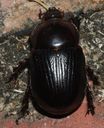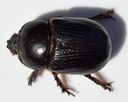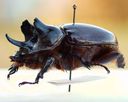Oryctini
Oryctini
Classification
- Phylum: Arthropoda
- Subphylum: Hexapoda
- Class: Insecta
- Order: Coleoptera
- Suborder: Polyphaga
- Superfamily: Scarabaeoidea
- Family: Scarabaeidae
- Subfamily: Dynastinae
- Tribe: Oryctini
Pronunciation
How to pronounce Oryctini: /ɔˈrɪktɪnaɪ/
These audio files are automatically generated. While they are not always 100% accurate, they are a good starting point.
Images






Summary
Oryctini is a diverse tribe of beetles known for their ecological role in decomposition and their notable physical characteristics, particularly in males. Found primarily in tropical regions, they play a vital part in the ecosystems they inhabit.
Physical Characteristics
Many species within the Oryctini tribe are characterized by their robust body structure and distinctive horns, particularly in the male specimens which often exhibit pronounced rhinoceros-like features.
Identification Tips
Males can be identified by their prominent horns on the head or pronotum, while females usually lack such features and have a more rounded body shape.
Habitat
They primarily inhabit areas with decaying organic matter, such as rotten wood in tropical and subtropical regions.
Distribution
Oryctini are found worldwide, especially predominant in tropical regions, with specific occurrences in eastern and southern United States.
Diet
Oryctini beetles primarily feed on decaying wood, plant matter, and sometimes sap, playing a crucial role in decomposition.
Life Cycle
The life cycle of Oryctini includes egg, larval, pupal, and adult stages, with larvae often developing within decaying organic material.
Reproduction
Reproductive habits vary, but generally, females lay eggs in suitable substrates rich in decaying organic matter to support larval development.
Predators
Natural predators of Oryctini include birds, mammals, and other insects that feed on beetles.
Ecosystem Role
Oryctini beetles are important decomposers, contributing to soil health and nutrient recycling through their feeding habits.
Economic Impact
Some species within the Oryctini are considered pests due to their feeding on crops and ornamental plants.
Collecting Methods
- Light traps
- Hand collecting during the night
- Baiting with decaying organic materials
Preservation Methods
- Pinning specimens
- Storing in alcohol for DNA analysis
Evolution
The Oryctini tribe has evolved various morphological adaptations, including horn development, likely as an evolutionary strategy for sexual selection among males.
Similar Taxa
Misconceptions
The term 'rhinoceros beetles' is often mistakenly used for various unrelated beetle species across different families.
Tags
- Oryctini
- Beetles
- Rhinoceros Beetles
- Decomposers
- Scarabaeidae